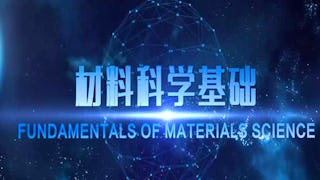Wir erforschen "10 Dinge", die von der Auswahl an Materialien, die Ingenieuren in ihrem Beruf zur Verfügung stehen, bis hin zu den vielen mechanischen und elektrischen Eigenschaften von Materialien reichen, die für ihren Einsatz in verschiedenen technischen Bereichen wichtig sind. Am Ende des Kurses werden Sie in der Lage sein: * die wichtigen Aspekte der Materialien, die in modernen technischen Anwendungen verwendet werden, zu erkennen, * das zugrundeliegende Prinzip der Materialwissenschaft zu erklären: "Struktur führt zu Eigenschaften", * die Rolle von thermisch aktivierten Prozessen bei vielen dieser wichtigen "Dinge" zu erkennen - wie durch die Arrhenius-Beziehung veranschaulicht. * jedes dieser Themen auf Probleme zu beziehen, die sich in Ihrem Leben und bei Ihrer Arbeit ergeben haben (oder möglicherweise ergeben könnten). Wenn Sie das Thema vertiefen möchten, können Sie das Lehrbuch von Dr. Shackelford erwerben: J.F. Shackelford, Introduction to Materials Science for Engineers, Eighth Edition, Pearson Prentice-Hall, Upper Saddle River, NJ, 2015

Pflegen Sie Ihre Karriere mit von Experten geleiteten Programmen, arbeitsplatztauglichen Zertifikaten und 10.000 Möglichkeiten zur Weiterentwicklung. Alles für 25 $/Monat, jährlich abgerechnet. Jetzt sparen


Werkstoffkunde: 10 Dinge, die jeder Ingenieur wissen sollte

Dozent: James Shackelford
105.752 bereits angemeldet
Bei  enthalten
enthalten
(4,466 Bewertungen)
Wichtige Details

Zu Ihrem LinkedIn-Profil hinzufügen
11 Aufgaben
Erfahren Sie, wie Mitarbeiter führender Unternehmen gefragte Kompetenzen erwerben.


Erwerben Sie ein Karrierezertifikat.
Fügen Sie diese Qualifikation zur Ihrem LinkedIn-Profil oder Ihrem Lebenslauf hinzu.
Teilen Sie es in den sozialen Medien und in Ihrer Leistungsbeurteilung.

In diesem Kurs gibt es 5 Module
Willkommen zu Woche 1! In Lektion eins lernen Sie anhand von Beispielen aus dem täglichen Leben die sechs Kategorien von technischen Materialien kennen und wir werden besprechen, wie die Struktur dieser Materialien zu ihren Eigenschaften führt. In Lektion zwei erfahren Sie, wie Punktdefekte die Diffusion in Festkörpern erklären. Wir werden die Kristallographie erläutern - die Anordnung der Atome auf atomarer Ebene, die wir mit dem Elektronenmikroskop sehen können. Wir werden auch die Arrhenius-Beziehung beschreiben und sie auf die Anzahl der Leerstellen in einem Kristall anwenden. Abschließend werden wir erörtern, wie Punktdefekte die Festkörperdiffusion erleichtern, und die Arrhenius-Beziehung auf die Festkörperdiffusion anwenden.
Das ist alles enthalten
10 Videos2 Aufgaben
Willkommen zu Woche 2! In Lektion drei werden wir entdecken, wie Versetzungen in der atomaren Struktur von Materialien plastische (dauerhafte) Verformungen erklären. Sie werden lernen, einen linearen Defekt zu definieren und sehen, wie sich Materialien durch Versetzungsbewegungen verformen. Lektion vier vergleicht Spannung mit Dehnung und stellt die "großen vier" mechanischen Eigenschaften Elastizität, Streckgrenze, Zugfestigkeit und Duktilität vor. Sie werden beurteilen, was jenseits der Zugfestigkeit eines Objekts passiert. Und Sie erfahren etwas über eine fünfte wichtige Eigenschaft - die Zähigkeit.
Das ist alles enthalten
10 Videos2 Aufgaben
Willkommen zu Woche 3! In Lektion fünf werden wir uns mit der Kriechverformung beschäftigen und lernen, eine Kriechkurve zu analysieren. Wir werden die Arrhenius-Beziehung auf die Kriechverformung anwenden und die Mechanismen der Kriechverformung identifizieren. In Lektion sechs erfahren wir, dass das Phänomen des Übergangs von duktil zu spröde mit einer bestimmten Kristallstruktur zusammenhängt (dem kubisch-raumzentrierten Körper). Außerdem lernen wir, den Übergang von duktil zu spröde für weitere Analysen aufzuzeichnen.
Das ist alles enthalten
8 Videos2 Aufgaben
Willkommen zu Woche 4! In Lektion sieben werden wir das Konzept der kritischen Fehler untersuchen. Wir werden die Bruchzähigkeit und die Größe kritischer Fehler mit Hilfe des Design Plots definieren. Wir werden auch unterscheiden, wie wir Dinge auf gute und schlechte Weise brechen. Lektion acht beschäftigt sich mit dem Konzept der Ermüdung bei technischen Materialien. Wir definieren Ermüdung und untersuchen die Ermüdungskurve und die Ermüdungsfestigkeit. Wir werden auch die Mechanismen der Ermüdung identifizieren.
Das ist alles enthalten
10 Videos2 Aufgaben
Willkommen zu Woche 5! In Lektion neun beschäftigen wir uns damit, wie man Dinge schnell und langsam macht. Wir werden das Blei-Zinn-Phasendiagramm untersuchen und seine praktischen Anwendungen als Beispiel für die langsame Herstellung von Dingen betrachten. Dann werden wir das TTT-Diagramm für eutektoiden Stahl auswerten und diffusive mit diffusionslosen Umwandlungen mit dem TTT-Diagramm vergleichen, um zu sehen, wie wir Dinge schnell herstellen. Lektion zehn ist eine kurze Geschichte von Halbleitern. Hier besprechen wir die Rolle von Halbleitermaterialien in der modernen Elektronikindustrie. Unser Freund Arrhenius ist wieder da, und dieses Mal wenden wir die Arrhenius-Beziehung sowohl auf intrinsische als auch auf extrinsische Halbleiter an. Wir werden uns auch das kombinierte intrinsische und extrinsische Verhalten ansehen.
Das ist alles enthalten
12 Videos3 Aufgaben
Dozent

Empfohlen, wenn Sie sich für Maschinenwesen interessieren

Shanghai Jiao Tong University

Arizona State University

Arizona State University

Arizona State University
Warum entscheiden sich Menschen für Coursera für ihre Karriere?




Bewertungen von Lernenden
4.466 Bewertungen
- 5 stars
76,24 %
- 4 stars
20,04 %
- 3 stars
2,95 %
- 2 stars
0,51 %
- 1 star
0,24 %
Zeigt 3 von 4466 an
Geprüft am 23. Nov. 2016
It is a really good course. I would recommend it to everyone interested in materials or engineering. This course helped me get a better understanding of some fundamental concepts of engineering.
Geprüft am 30. Juli 2020
The course is nice and allows me to recover my 20-year old university knowledge (some topics) rapidly. I found some new and interesting things as well. Merci for the good materials to Instructor.
Geprüft am 23. Sep. 2020
This course is good for engineers. It illustrated many fundemental and important concept in materials science. The teacher is great who explain nearly everthings in details with words and experiments.

Neue Karrieremöglichkeiten mit Coursera Plus
Unbegrenzter Zugang zu 10,000+ Weltklasse-Kursen, praktischen Projekten und berufsqualifizierenden Zertifikatsprogrammen - alles in Ihrem Abonnement enthalten
Bringen Sie Ihre Karriere mit einem Online-Abschluss voran.
Erwerben Sie einen Abschluss von erstklassigen Universitäten – 100 % online
Schließen Sie sich mehr als 3.400 Unternehmen in aller Welt an, die sich für Coursera for Business entschieden haben.
Schulen Sie Ihre Mitarbeiter*innen, um sich in der digitalen Wirtschaft zu behaupten.
Häufig gestellte Fragen
Der Zugang zu Vorlesungen und Aufgaben hängt von der Art Ihrer Einschreibung ab. Wenn Sie einen Kurs im Prüfungsmodus belegen, können Sie die meisten Kursmaterialien kostenlos einsehen. Um auf benotete Aufgaben zuzugreifen und ein Zertifikat zu erwerben, müssen Sie die Zertifikatserfahrung während oder nach Ihrer Prüfung erwerben. Wenn Sie die Prüfungsoption nicht sehen:
Der Kurs bietet möglicherweise keine Prüfungsoption. Sie können stattdessen eine kostenlose Testversion ausprobieren oder finanzielle Unterstützung beantragen.
Der Kurs bietet möglicherweise stattdessen die Option 'Vollständiger Kurs, kein Zertifikat'. Mit dieser Option können Sie alle Kursmaterialien einsehen, die erforderlichen Bewertungen abgeben und eine Abschlussnote erhalten. Dies bedeutet auch, dass Sie kein Zertifikat erwerben können.
Wenn Sie ein Zertifikat erwerben, erhalten Sie Zugang zu allen Kursmaterialien, einschließlich der benoteten Aufgaben. Nach Abschluss des Kurses wird Ihr elektronisches Zertifikat zu Ihrer Erfolgsseite hinzugefügt - von dort aus können Sie Ihr Zertifikat ausdrucken oder zu Ihrem LinkedIn-Profil hinzufügen. Wenn Sie die Kursinhalte nur lesen und ansehen möchten, können Sie den Kurs kostenlos besuchen.
Sie haben Anspruch auf eine vollständige Rückerstattung bis zwei Wochen nach Ihrem Zahlungsdatum oder (bei Kursen, die gerade erst begonnen haben) bis zwei Wochen nach Beginn der ersten Sitzung des Kurses, je nachdem, welcher Zeitpunkt später liegt. Sie können keine Rückerstattung erhalten, sobald Sie ein Kurszertifikat erworben haben, auch wenn Sie den Kurs innerhalb der zweiwöchigen Rückerstattungsfrist abschließen. Siehe unsere vollständigen Rückerstattungsbedingungen.
Weitere Fragen
Finanzielle Unterstützung verfügbar,

